Caryn’s Thoughts
 It seems that before every accepted type of warning system, there is a period of time when the warnings are either ignored by officials or the officials worry that such a warning will cause a panic among the people. In retrospect, however, the officials always wish that they had allowed the warnings to be posted, so that lives could have been saved. I can understand how the idea of mass panic could be a bit scary for officials, and people often don’t act in a way that could produce an orderly evacuation, in which everyone evacuates as if nothing is wrong.
It seems that before every accepted type of warning system, there is a period of time when the warnings are either ignored by officials or the officials worry that such a warning will cause a panic among the people. In retrospect, however, the officials always wish that they had allowed the warnings to be posted, so that lives could have been saved. I can understand how the idea of mass panic could be a bit scary for officials, and people often don’t act in a way that could produce an orderly evacuation, in which everyone evacuates as if nothing is wrong.
David Bernays and Charles Sawyer were two American scientists who were exploring the area around Yungay, Peru. They were climbing nearby Mount Huascarán, when they saw something that alarmed them. They noticed quite a bit of loose bedrock under a glacier. The scientists also knew that the region was prone to earthquakes. The mix of those two things, possible disasters on their own, could be catastrophic if they happened together. Bernays and Sawyer tried to save the residents of Yungay, Peru from the huge avalanche that was a very real possibility.
At the warning, the government became so outraged by the warning the scientists issued, that they ordered the them to take it back or go to prison. That was a big threat, and these were American scientists in a foreign country. I’m sure that the men were justifiably terrified. As a result of the threat and the fear it brought, the two scientists fled the country. Several years later, the men were proven right, when an avalanche killed most of Yungay’s 20,000 residents. I’m sure that being proven right didn’t do much for the two scientists’ feelings of horror at the very disaster that they had so correctly predicted. This was not going to be an “I told you so” moment. It was simply a tragedy…and it could have been prevented, if anyone had listened.
The May 31, 1970 undersea earthquake off the coast of Casma and Chimbote, north of Lima, triggered one of the most cataclysmic avalanches in recorded history. The avalanche wiped out the entire highland town of Yungay and most of its 25,000 inhabitants. Around 3:23pm, local time, while most people were tuned in to the Italy-Brazil FIFA World Cup Match, an earthquake struck the Peruvian departments of Ancash and La Libertad. The quake’s epicenter was located in the Pacific Ocean, where the Nazca Plate is subducted by the South American Plate, and recorded a magnitude of 8.0 on the Richter scale, with an intensity of up to 8 on the Mercalli scale. The quake lasted 45 seconds, and crumbled adobe homes, bridges, roads and schools across 83,000 square kilometers, an area larger than Belgium and the Netherlands combined. It was registered as one of the worst earthquakes ever to be experienced in South America. Damage and casualties were reported as far 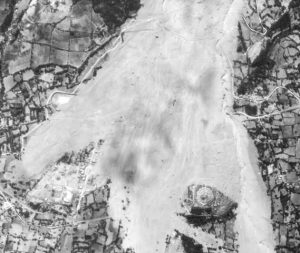 as Tumbes, Iquitos and Pisco, as well as in some parts of Ecuador and Brazil…but in Yungay, a small highland town in the picturesque Callejon de Huaylas, founded by Domingo Santo Tomás in 1540, the earthquake triggered an even greater calamity.
as Tumbes, Iquitos and Pisco, as well as in some parts of Ecuador and Brazil…but in Yungay, a small highland town in the picturesque Callejon de Huaylas, founded by Domingo Santo Tomás in 1540, the earthquake triggered an even greater calamity.
Following the quake, the glacier on the north face of Mount Huascarán broke free, causing 10 million cubic meters of rock, ice and snow to break away and tear down its slope at more than 120 miles, per hour. As it thundered down toward Yungay, and the town of Ranrahirca on the other side of the ridge, the wave of debris picked up more glacial deposits and began to spit out mud, dust, and boulders. By the time it reached the valley, just three minutes later, the 3,000 feet wide wave was estimated to have consisted of about 80 million cubic meters of ice, mud, and rocks. Within moments, what was Yungay and its 25,000 inhabitants, many of whom had rushed into the church to pray after the earthquake struck, were buried and crushed by the landslide. The smaller village of Ranrahirca was buried as well, the second time in a decade, but it is the image of lone surviving palm trees in the Yungay cemetery that is burned into Peru’s memory.
“We were on our way from Yungay to Caraz when the earthquake struck,” survivor Mateo Casaverde recalls. “When we stepped out of the car, the earthquake was almost over. Then we heard a deep, low rumble, something distinct from the noise an earthquake makes, but not too different. It came from the Huascarán. Then we saw, half-way between Yungay and the mountain, a giant cloud of dust. Part of the Huascarán was coming toward us. It was approximately 3:24pm. Where we were, the only place that offered us relative security, was the cemetery, built upon an artificial hill, like a pre-Incan tomb. We ran approximately 100 meters before we got to the cemetery. Once I reached the top, I turned to see Yungay. I could clearly see a giant wave of gray mud, about 60 meters high. Moments later, the landslide hit the cemetery, about five meters below our feet. The sky went dark because of all the dust, mostly from all of the destroyed homes. We turned to look, and Yungay, as well as its thousands of inhabitants, had completely disappeared.”
The reported death toll from what came to be known as Peru’s Great Earthquake totaled more than 74,000 people. About 25,600 were declared missing, over 143,000 were injured and more than one million left homeless. The city of Huaraz was rubble, the valley buried in mud, and coastal towns such as Casma were also shaken to the ground. In Yungay, only some 350 people survived, including the few who were able to climb to the town’s elevated step-like cemetery. Built between 1892 and 1903, the cemetery was designed by Swiss architect Arnoldo Ruska, who also died as a result of the landslide. Among the survivors were 300 children, who had been taken to the circus at the local stadium, set on higher ground and on the outskirts of the town.
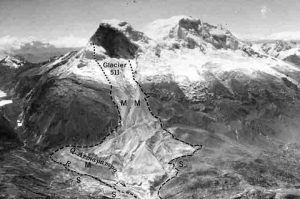 Today, Yungay is a national cemetery and the Huascarán’s victims are still vividly remembered. Because the Peruvian government has forbidden excavation in the area, crosses and tombs mark the spots where homes once stood, engraved with the names of those never found. A crushed intercity bus, four of the original palm trees that once crowned the city’s main plaza and remnants of the cathedral still stand. Though life goes on and a new Yungay has since been rebuilt, a few miles away from the original city, Peru does not forget. In 2000, in memory of the victims of the deadliest seismic disaster in the history of Latin America, the government declared May 31 “Natural Disaster Education and Reflection Day.”
Today, Yungay is a national cemetery and the Huascarán’s victims are still vividly remembered. Because the Peruvian government has forbidden excavation in the area, crosses and tombs mark the spots where homes once stood, engraved with the names of those never found. A crushed intercity bus, four of the original palm trees that once crowned the city’s main plaza and remnants of the cathedral still stand. Though life goes on and a new Yungay has since been rebuilt, a few miles away from the original city, Peru does not forget. In 2000, in memory of the victims of the deadliest seismic disaster in the history of Latin America, the government declared May 31 “Natural Disaster Education and Reflection Day.”
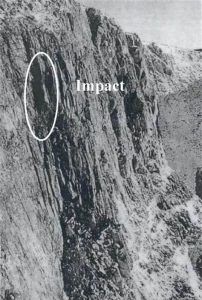
 Wyoming doesn’t have as many plane crashes as other states…at least not to my knowledge. It’s probably because of the fact that with a smaller population, there are fewer flights in and out…at least in the past. That may have changed in more recent years. Nevertheless, on October 6, 1966, a DC-4…United Airlines Flight 409, with 66 people on board, flew into the side of a cliff on Medicine Bow Peak in the Snowy Mountain Range near Laramie, Wyoming. At that time, it was the worst air disaster in United States history.
Wyoming doesn’t have as many plane crashes as other states…at least not to my knowledge. It’s probably because of the fact that with a smaller population, there are fewer flights in and out…at least in the past. That may have changed in more recent years. Nevertheless, on October 6, 1966, a DC-4…United Airlines Flight 409, with 66 people on board, flew into the side of a cliff on Medicine Bow Peak in the Snowy Mountain Range near Laramie, Wyoming. At that time, it was the worst air disaster in United States history.
Lost in the disaster were three crew members, two infants, several military personnel, and five female members of the Mormon Tabernacle Choir. Their four-engine propeller plane took off from the now-closed Stapleton International Airport in Denver that morning. Its destination was Salt Lake City, Utah. Jet airliners didn’t exist then, and propeller-driven airplanes necessarily flew at much lower altitudes. Things like not being able to pressurize the cabin, necessitated a lower flight level. Unfortunately, it also made air travel quite a bit more hazardous. Things like terrain collisions and weather issues were more common. Weather forecasts weren’t as sophisticated and the widely dispersed technology we have today was still a dream in some scientists mind.
The normal flight path of the Denver to Salt Lake route in those days, was north of Laramie around the high points of the Snowy Mountain Range. It seems to be a long way around to us these days, but it was necessary back then. Still, pilots would occasionally fly over the range to save time. In retrospect, I’m sure many would regret that practice after hearing about United Airlines Flight 409, and the horrible outcome of that shortcut.
The night of October 5th brought high winds and snow…both normal for Wyoming this time of year. The conditions over the mountains were most likely less than ideal as UA409 crossed the range the next morning. At 7:26am on October 6th, the plane flew into the side of the mountain…at full speed. There were no “black boxes” at that, so the only way to determine the time was that the onboard clocks that were recovered after the crash were frozen at the moment of impact. According to the investigation report, the plane exploded on impact, littering the mountain with debris over a mile-long path. Two huge black marks marred the mountain, as oil from the engines splattered across the surrounding terrain. The impact site was just 25 feet below the crest of the mountain, at 12,000 feet…25 feet from clearing the top. That is so shocking…that I find it difficult to wrap my mind around that fact. If they could have made it just a little over 25 feet higher, they just might have made it.
After the impact, the tail section separated from the rest of the aircraft, fell down the cliff, and rested on a ledge halfway down. A search for the plane ensued, and an F-80 fighter jet based out of Cheyenne spotted the wreck a little more than four hours after the crash. The pilots of the jet told of bad weather in the area. With the location, rescuers headed to the area, but with the windy weather caused, it took several attempts to locate the wreckage. It took them until Thursday afternoon to actually reach the crash site. Then began the gruesome task of recovering the dead. Bodies were lowered by rope and pully down the cliff. Some bags were marked “spare parts.” All the dead were identified, and their remains carried out on horseback.
To this day, the cause of the crash is uncertain. The pilot was very skilled, and the shortcut over the mountain would not have saved a lot of time. It is unknown why he took the shortcut, or why he flew at such a low 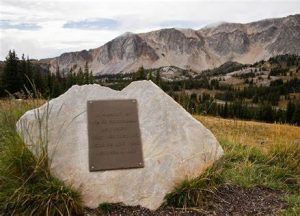
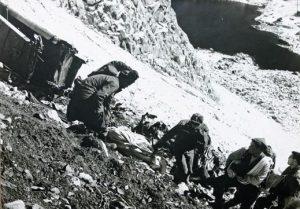 altitude. The wreckage remains at the site to this day, as often happened back then. A hiker made a YouTube video of his trip there, where he found pieces of scrap metal, wires, and rusted engine parts from the plane. He also found a shoe that appears to be from that era. I imagine the finds left the hiker with a feeling of being in an almost hallowed ground…almost like a grave site.
altitude. The wreckage remains at the site to this day, as often happened back then. A hiker made a YouTube video of his trip there, where he found pieces of scrap metal, wires, and rusted engine parts from the plane. He also found a shoe that appears to be from that era. I imagine the finds left the hiker with a feeling of being in an almost hallowed ground…almost like a grave site.
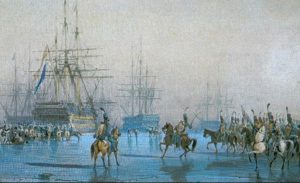 Ice flows in the world’s waterways has been known to freeze ships in place, leaving them stuck, often damaged, and sometimes…captured. The date was January 23, 1795, and the Dutch fleet was at anchor in the Zuiderzee, fifty miles north of Amsterdam. It was the height of the French Revolution, and the winter in the area was not cooperating with the fleet. In fact, some people in the port town of Den Helder said it was the worst winter they had seen in many years.
Ice flows in the world’s waterways has been known to freeze ships in place, leaving them stuck, often damaged, and sometimes…captured. The date was January 23, 1795, and the Dutch fleet was at anchor in the Zuiderzee, fifty miles north of Amsterdam. It was the height of the French Revolution, and the winter in the area was not cooperating with the fleet. In fact, some people in the port town of Den Helder said it was the worst winter they had seen in many years.
A unit of French soldiers was approaching the town that night, under the command of brigadier-general De Winter. Everyone in town knew it. A few days earlier, seven self-governing provinces had declared independence and a loose alliance. The old Republic had been ousted. Den Helder was now part of the newly declared Batavian Republic. Emotions were running high with excitement among the people, and the arrival of soldiers from the revolutionary new French Republic was welcomed. Having the Dutch Fleet in the port was oppressive, and they were ready for it to end. There was much talk of France, and of all that had been achieved there in recent years. The revolution was real, the monarchies had fled, and battles on sea and on land were being won. A bright future, free from the tyranny of the old leaders and old politics was within their grasp. The people felt hope again.
The only people who didn’t know about the French cavalry was the men on the Dutch fleet…not that it would have really mattered. It was almost midnight when the French detachment arrived. It was freezing, and the men were bundled in every garment they possessed…a great troop of horsemen riding double toward the port. People left the inns and public houses, cheering them on, and pointing out toward the Zuiderzee, where the Dutch fleet was anchored. The captain of the cavalry dismounted at the water’s edge…almost amazed. The reports were true. There, in the crisp light of the moon and stars he could see ships anchored in the bay, but he was looking not across the water. He was gazing across a great sheet of grey ice. The Zuiderzee, was shallow and fed by fresh water…and it had frozen over. The fleet in the bay was icebound and trapped. The fleet of the old Dutch Republic must have been sitting there for days, he said, but until yesterday its presence had been hidden from the town by fog and snow. Layers of snowfall had frozen and thickened the ice, which was now many feet deep.
After the scouts checked out the situation and returned, the Captain asked, “How many ships?” When he received his answer, he made his decision. This was too good a chance to miss. Messages were dispatched to General De Winter, and the soldiers were given their orders. They were to wrap the horse’s hooves in cloth, both to muffle the sound of their approach and to minimize the chance of the heavy hooves and steel horseshoes shattering the ice. They were to approach slowly and cautiously, and they were to be silent. They were to listen for the cracking of the ice, and be prepared to make an careful retreat if necessary. Onto the ice they went, horsemen and infantry, silent as the clouds of vapor that streamed from their mouths and noses as they breathed. There were eighty five warships and twenty merchant vessels trapped in the ice. The fleet represented most of the naval power of the deposed Dutch Republic, its capture would be a huge win for the French. As they advanced carefully across the ice, their ears strained for the creaking noises which would herald disaster. They became more confident. The ice held. They gathered speed. The dark ships growing larger as they came closer.
There were a few lights coming from the fleet, and the captain stopped his men short before they reached the first vessels. As quietly as possible, he sent men on foot in between the sides of the great ships. It took an hour for his men to survey the situation, and to identify the command vessel. This was a great 86 gunner, near to the French position. The captain gave his orders quickly and quietly. A detachment of horsemen was sent back, with orders to ride the shore of the Zuiderzee and establish exactly how far out the ice extended. Then, the captain dismounted and walked with the great body of his infantry round to the great command ship. They carried ropes and grappling hooks. The captain had his men prime their rifles, and then they threw hooks with ropes onto the ships.
At the sound of the first hooks on the deck a dozing watchman woke up. By the time he was awake enough to raise a cry, the captain and hundred men were on the deck. The watchman called out and ran toward the great bell, meaning to raise the alarm, but he slipped on the icy deck. There was a rush of feet, and he found himself staring up at the barrel of a musket. “Silence!” hissed the soldier. The command ship had been boarded. When the admiral was rousted from his bed and presented himself on deck, he knew that there was no hope of 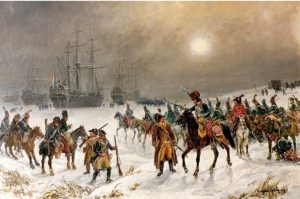 resistance. The conversation he had with the young French captain of the cavalry was courteous. There would be more French troops arriving at first light, and General De Winter would arrive with them. De Winter was now the master of the Dutch fleet, and he would give clear orders. The admiral had no choice, but to give orders that the fleet surrender. When De Winter arrived in the morning the whole fleet was secured and explored in the grey morning light. The captain of the cavalry was promoted on the spot, and the admiral and his crews swore allegiance to the French Republic. A great victory had been won, without a drop of blood spilled or a single shot fired. It was the only such event ever recorded in military history.
resistance. The conversation he had with the young French captain of the cavalry was courteous. There would be more French troops arriving at first light, and General De Winter would arrive with them. De Winter was now the master of the Dutch fleet, and he would give clear orders. The admiral had no choice, but to give orders that the fleet surrender. When De Winter arrived in the morning the whole fleet was secured and explored in the grey morning light. The captain of the cavalry was promoted on the spot, and the admiral and his crews swore allegiance to the French Republic. A great victory had been won, without a drop of blood spilled or a single shot fired. It was the only such event ever recorded in military history.
 Being Jewish during the Holocaust meant doing whatever it took to survive. For some, that means hiding in walls or changing one’s identity, then so be it. Still, there were other Jews who had no way of doing either of these things, so they had to make due with what they had. The path to freedom and life was a difficult one, no matter what path they chose. There were close calls, starvation, fear, and a lot of quiet. Two families decided that they had no choice, but to take refuge in a hayloft over a pigsty offered by the owner, Francisca Halamajowa, a kindly Polish Catholic woman, and her daughter, Helena, who protected these families.
Being Jewish during the Holocaust meant doing whatever it took to survive. For some, that means hiding in walls or changing one’s identity, then so be it. Still, there were other Jews who had no way of doing either of these things, so they had to make due with what they had. The path to freedom and life was a difficult one, no matter what path they chose. There were close calls, starvation, fear, and a lot of quiet. Two families decided that they had no choice, but to take refuge in a hayloft over a pigsty offered by the owner, Francisca Halamajowa, a kindly Polish Catholic woman, and her daughter, Helena, who protected these families.
The Malkin and Kinder families went into hiding in 1942, just before the town’s Jewish ghetto was liquidated, but unfortunately, after 4 year old Fay Malkin’s father and others were killed in an old brick factory nearby. Years later in 2011, Fay Malkin told of the heroic acts of Halamajowa. Fay Malkin almost died shortly before her 5th birthday, while hiding in that hayloft. She told the Holocaust remembrance gathering at UJA-Federation of New York on May 3rd: “Hitler didn’t win, we’re here.” Malkin tells of the 20 months that the family and two other families stayed hidden in order to stay alive…and to protect their protectors, who would have also lost their lives if they were caught.
The families worried that 4-year-old Fay would give them away with her crying. The little girl promised not to cry, but that is really a lot to ask of a little girl. Malkin couldn’t control herself once in the hayloft. After trying many other approaches, the adults finally made the excruciating decision to poison little Fay in order to save the rest. Malkin would have almost certainly been killed, if they were discovered. Malkin said her memory of the incident is faint, but she remembers pushing out the pill put in her mouth. Just before she was put in a bag to be buried, a doctor who was among those hiding felt a slight pulse. She was saved. “I became the miracle child,” she said. Having lived with the story her whole life, Fay smiled when she said that her crying after that was controlled by pillows. The families were saved, not only because of the kindness and courage of their fellow townspeople, but by the miracle of a little child that didn’t die. I realize that the fact that little Fay Malkin lived through the attempted poisoning may not seem like something that saved the families, but in reality, how could they have lived with themselves? Yes, they would have been alive, but they would have been almost as bad as the Nazis who were trying to kill them.
The Malkin family lived in Sokal, then part of Poland…now in Ukraine. Before World War II, there were 6,000 Jews in Sokal. By the end of the war, only about 30 had survived, and half of them were sheltered by Halamajowa. For 20 months, the families stayed in that tiny hayloft…never daring to leave or even make a sound. Halamajowa and her daughter, Helena, risked their lives by feeding them surreptitiously and otherwise helping them, all the while disguising their actions from her neighbors and the occupying German army. In July 1944, the town was liberated by the Soviets. When the Malkin and Kindler families were finally able to come down from the hayloft, they learned that Halamajowa had also been sheltering another Jewish family in a hole dug under her kitchen floor. What these two women did was above and beyond expectation, and very brave.
Of course, most Jews never spoke of the experience. They didn’t want to get anyone in trouble, and their 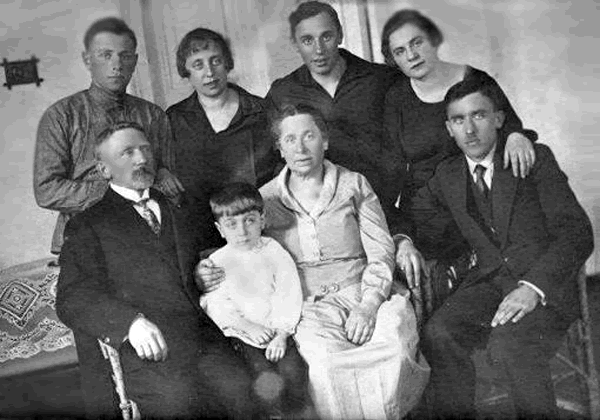 protectors felt the same way. They didn’t trust the government, even with the war over. Halamajowa died in Russia in 1960…never having revealed her secrets. Nevertheless, in 1986 she was honored at Yad Vashem as a Righteous Gentile…a fitting title. In 2007, Malkin, Maltz, and several others from the hayloft and celler families, returned to Sokal. The trip was part of a film project that led to No. 4 Street of Our Lady. A basis for the film was the diary kept by Fay’s cousin, Moshe Maltz. Malkin said it was important but highly emotional going back to Sokal, especially seeing where her father was killed. Included in the group traveling there were the two granddaughters of Halamajowa, who now live in Connecticut. I’m sure it was very emotional.
protectors felt the same way. They didn’t trust the government, even with the war over. Halamajowa died in Russia in 1960…never having revealed her secrets. Nevertheless, in 1986 she was honored at Yad Vashem as a Righteous Gentile…a fitting title. In 2007, Malkin, Maltz, and several others from the hayloft and celler families, returned to Sokal. The trip was part of a film project that led to No. 4 Street of Our Lady. A basis for the film was the diary kept by Fay’s cousin, Moshe Maltz. Malkin said it was important but highly emotional going back to Sokal, especially seeing where her father was killed. Included in the group traveling there were the two granddaughters of Halamajowa, who now live in Connecticut. I’m sure it was very emotional.
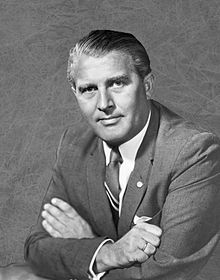 There is good that comes from science, and there is bad too, unfortunately. Things like weapons of warfare would most likely fall into the bad that comes from science. Still, weapons are necessary, and maybe it isn’t the weapon that is bad, but rather the user. Wernher von Braun was a rocket scientist in Hitler’s Germany. His job was to build bigger and more dangerous weapons. The V-2 missile was the culmination of von Braun’s work so far. On October 3, 1942, von Braun tested the V-2 missile. The missile was fired successfully from Peenemunde, as island off Germany’s Baltic coast. It traveled 118 miles in that test; and later, in evil weapon style, it proved extraordinarily deadly in the war. The V-2 missile was the precursor to the Intercontinental Ballistic Missiles (ICBMs) of the postwar era.
There is good that comes from science, and there is bad too, unfortunately. Things like weapons of warfare would most likely fall into the bad that comes from science. Still, weapons are necessary, and maybe it isn’t the weapon that is bad, but rather the user. Wernher von Braun was a rocket scientist in Hitler’s Germany. His job was to build bigger and more dangerous weapons. The V-2 missile was the culmination of von Braun’s work so far. On October 3, 1942, von Braun tested the V-2 missile. The missile was fired successfully from Peenemunde, as island off Germany’s Baltic coast. It traveled 118 miles in that test; and later, in evil weapon style, it proved extraordinarily deadly in the war. The V-2 missile was the precursor to the Intercontinental Ballistic Missiles (ICBMs) of the postwar era.
German scientists, led by von Braun, had been working on the development of these long-range missiles since the 1930s. I don’t know if von Braun was doing this work by choice, which would make him very likely as evil as the weapons of destruction he made, or whether, like so many of the German people under Hitler’s evil rule, he simply had no say in the matter. Whatever the case may be, von Braun was good at what he did. The science, which clearly must have fascinated him, was a work to which he was well suited. He understood it. He knew how to make it do hat he wanted it to do, and become what he wanted it to become…or, at least what he was told to make it become. Still, it took time to perfect. Three trial launches had already failed. The fourth in the series, known as A-4, 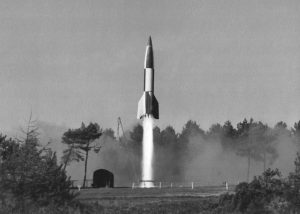 finally saw the V-2, a 12-ton rocket capable of carrying a one-ton warhead, successfully launched. I wonder just how much pressure was on von Braun at that fourth launch attempt. Could it have cost him his life, or his freedom, if he did not successfully create this weapon that Hitler wanted so badly.
finally saw the V-2, a 12-ton rocket capable of carrying a one-ton warhead, successfully launched. I wonder just how much pressure was on von Braun at that fourth launch attempt. Could it have cost him his life, or his freedom, if he did not successfully create this weapon that Hitler wanted so badly.
The V-2 was unique in several ways. First, it was virtually impossible to intercept, making it a serious threat to anyone it was aimed at. Upon launching, the missile rises six miles straight up. Then, it proceeds on an arced course, cutting off its own fuel according to the range desired. The missile then tips over and falls on its target-at a speed of almost 4,000 miles per hour. That would make it extremely difficult to blow up in flight, since hitting something moving at that speed would take serious accuracy, and heat seeking missiles were not developed yet. The missile hits with such force that it burrows itself several feet into the ground before exploding. In addition, the missile had the potential of flying a distance of 200 miles, and the launch pads were portable, making them impossible to detect before firing.
September 6, 1944 became the first real use of the V-2, when two missiles were fired at Paris. On September 8, two more were fired at England, which would be followed by more than 1,100 more during the next six months. More than 2,700 British citizens died because of the rocket attacks. After the war, both the United States and the Soviet Union captured samples of the rockets for reproduction. They also captured the scientists 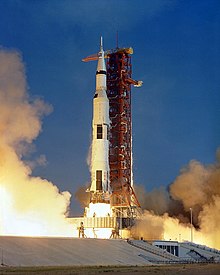 responsible for their creation. Following the war, von Braun was secretly moved to the United States, along with about 1,600 other German scientists, engineers, and technicians, as part of Operation Paperclip. He worked for the United States Army on an intermediate-range ballistic missile program, and he developed the rockets that launched the United States’ first space satellite Explorer 1.
responsible for their creation. Following the war, von Braun was secretly moved to the United States, along with about 1,600 other German scientists, engineers, and technicians, as part of Operation Paperclip. He worked for the United States Army on an intermediate-range ballistic missile program, and he developed the rockets that launched the United States’ first space satellite Explorer 1.
His group was assimilated into NASA, where he served as director of the newly formed Marshall Space Flight Center and as the chief architect of the Saturn V super heavy-lift launch vehicle that propelled the Apollo spacecraft to the Moon. He also advocated for a human mission to Mars. In 1967, von Braun was inducted into the National Academy of Engineering and in 1975, he received the National Medal of Science. Von Braun died on June 16, 1977 of pancreatic cancer in Alexandria, Virginia at age 65. He was buried at the Ivy Hill Cemetery. His gravestone quotes Psalm 19:1: “The heavens declare the glory of God; and the firmament sheweth his handywork” (KJV).
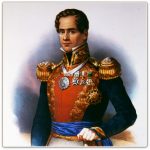
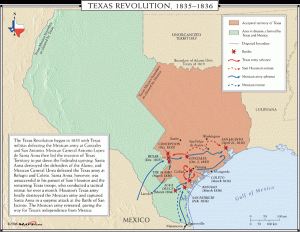 Since the 17th century, Texas, or Tejas as the Mexicans called it, had technically been a part of the Spanish empire. However, there were only about 3,000 Spanish-Mexican settlers in Texas, even as late as the 1820s, and Mexico City’s hold on the territory was very weak. Tensions were growing between Mexico and Texas, and on October 2, 1835, the area erupted into violence when Mexican soldiers attempted to disarm the people of Gonzales. People just don’t take kindly to having their guns taken away in any era, I guess. The citizens of Texas chose a war for independence of allowing the government to take their guns.
Since the 17th century, Texas, or Tejas as the Mexicans called it, had technically been a part of the Spanish empire. However, there were only about 3,000 Spanish-Mexican settlers in Texas, even as late as the 1820s, and Mexico City’s hold on the territory was very weak. Tensions were growing between Mexico and Texas, and on October 2, 1835, the area erupted into violence when Mexican soldiers attempted to disarm the people of Gonzales. People just don’t take kindly to having their guns taken away in any era, I guess. The citizens of Texas chose a war for independence of allowing the government to take their guns.
Mexico had just won it’s own independence from Spain in 1821. At this point, Mexico welcomed large numbers of Anglo-American immigrants into Texas. They were hoping that these citizens would become loyal Mexican citizens, thereby keeping the territory from falling into the hands of the United States. During the next decade men like Stephen Austin brought more than 25,000 people to Texas, most of them Americans. But while these emigrants legally became Mexican citizens, they continued to speak English, formed their own schools, and had closer trading ties to the United States than to Mexico.
The situation exacerbated in 1835, the president of Mexico, Antonio Lopez de Santa Anna, overthrew the constitution and appointed himself dictator. Recognizing that the “American” Texans were likely to use his rise to power as an excuse to secede, Santa Anna ordered the Mexican military to begin disarming the Texans whenever possible. He underestimated the people. His attempt to disarm proved more difficult than he could have ever imagined, and the situation exploded on that October day in 1835.
That day, the Mexican soldiers were attempting to take a small cannon from the village of Gonzales. To their surprise, they encountered much stiffer resistance than they ever thought possible from a hastily assembled militia of Texans. After a rather brief fight, the Mexicans retreated and the Texans kept their cannon. The determined Texans would continue to battle Santa Ana and his army for another year and a half before winning their independence and establishing the Republic of Texas. This truly goes to show that a nation, whose citizens are armed, is much more likely to be able to fend off their enemies…even if that enemy is a tyrannous government; than an nation of disarmed citizens. Yes, the ensuing war lasted for another year and a half, but 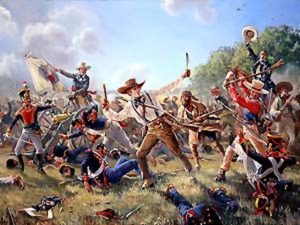
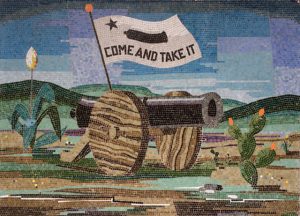 the people won their independence in the end. They later went on to become a part of the United States, and they continue to carry their guns to this day. The people of Texas are just as adamant about their right to bear arms today as they were in 1835, as are a good number of their fellow Americans. It’s a fight that would not likely be won by the government today either. The American people won’t accept the loss of guns without a fight of epic proportions!!
the people won their independence in the end. They later went on to become a part of the United States, and they continue to carry their guns to this day. The people of Texas are just as adamant about their right to bear arms today as they were in 1835, as are a good number of their fellow Americans. It’s a fight that would not likely be won by the government today either. The American people won’t accept the loss of guns without a fight of epic proportions!!
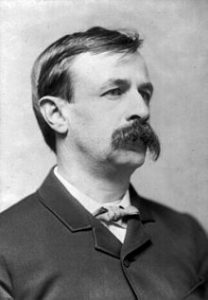 Author of Looking Backward:2000-1887, Edward Bellamy, wrote in the novel first published in 1888 novel, asked his readers to imagine a scene in which a time-traveler from 1887 reacts to a technological advance from the early 21st century that he describes as, “An arrangement for providing everybody with music in their homes, perfect in quality, unlimited in quantity, suited to every mood, and beginning and ceasing at will.” It’s amazing to me that many writers of fiction, see the future in a way most of us can’t. Their imaginations manage to picture a future that sometimes, proves to be uncannily like real life in the future. Jules Verne was that way too.
Author of Looking Backward:2000-1887, Edward Bellamy, wrote in the novel first published in 1888 novel, asked his readers to imagine a scene in which a time-traveler from 1887 reacts to a technological advance from the early 21st century that he describes as, “An arrangement for providing everybody with music in their homes, perfect in quality, unlimited in quantity, suited to every mood, and beginning and ceasing at will.” It’s amazing to me that many writers of fiction, see the future in a way most of us can’t. Their imaginations manage to picture a future that sometimes, proves to be uncannily like real life in the future. Jules Verne was that way too.
In Bellamy’s imagination…almost inventor-like, this astonishing feat would be accomplished by a vast network of wires connecting individual homes with centrally located concert halls staffed round-the-clock with live performers. Of course, that would be a difficult task to pull off, but in the end, someone else took care of the finer points of Bellamy’s vision. As we all know, today we can turn on a radio, whether plugged into the outlets in our home, or a portable version that we carry around, and of course, these days every smart phone has the ability to listen wirelessly to radio stations, watch television, and download all the music our hearts could desire.
Bellamy’s vision came to pass much sooner than the 2000 predicted date, and without all the wiring he thought would be needed, but he wasn’t too far off in what the end outcome would be…at least for the homes. I doubt it ever occurred to him that it could all be done wirelessly, or that telephones could have the same capability and much more. Of course, at that time, telephones were still in their very primitive stages. On October 1, 1920, Scientific American magazine reported that the rapidly developing medium of radio would soon be used to broadcast music. A revolution in the role of music in everyday life was about to be born.
“It has been well known for some years that by placing a form of telephone transmitter in a concert hall or at any point where music is being played the sound may be carried over telephone wires to an ordinary telephone receiver at a distant point,” began the bulletin in the October 1, 1920 issue of the popular science monthly, “but it is only recently that a method of transmitting music by radio has been found possible.”
People still argue about radio’s origins to this day, but its basic workings had been understood for upwards of 20 years at the time of this announcement. It was only in the years immediately following World War I, 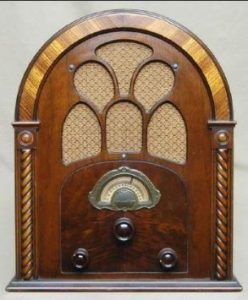 however, that radio made the transition from scientific curiosity to practical technology. Then, by late 1919, Britain, the United States and elsewhere were beginning experiments that would lead to the breakthrough use of radio not just as a replacement for the telegraph, but as a communications and entertainment medium. The idea that Bellamy suggested, was coming to pass…a full 81 years sooner than he had expected.
however, that radio made the transition from scientific curiosity to practical technology. Then, by late 1919, Britain, the United States and elsewhere were beginning experiments that would lead to the breakthrough use of radio not just as a replacement for the telegraph, but as a communications and entertainment medium. The idea that Bellamy suggested, was coming to pass…a full 81 years sooner than he had expected.
It was those experiments that led to the public announcement in Scientific American. “Music can be performed at any place, radiated into the air through an ordinary radio transmitting set and received at any other place, even though hundreds of miles away,” the report continued, noting that “the music received can be made as loud as desired by suitable operation of the receiving apparatus.” “Experimental concerts are at present being conducted every Friday evening from 8:30 to 11:00 by the Radio Laboratory of the Bureau of Standard. The possibilities of such centralized radio concerts are great and extremely interesting.” Bellamy’s dream had come to pass.
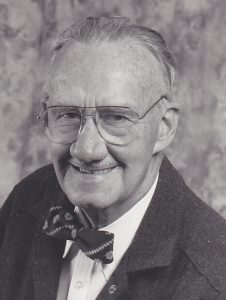 I am amazed at the number of inventions that have changed our world, but when they were invented, they were not what the inventor was trying to invent. Basically, while trying to make one thing, or repair something, the inventor stumbled on something else, and made an important discovery. Wilson Greatbatch was an inventor who had been quite successful, having 150 patents to his credit at the time of his accidental invention. Overall, in his lifetime, he was credited with an astonishing total of 325 patents for his many great brainstorms. Patents aside, Greatbatch will be best remembered for the invention and development of the first implantable pacemaker, a device which has improved, saved, and extended countless lives since its first use in 1960. Worldwide, approximately three million people currently benefit from Greatbatch’s discovery, with an additional 600,000 being implanted every year. It was not what he had be trying to make, however.
I am amazed at the number of inventions that have changed our world, but when they were invented, they were not what the inventor was trying to invent. Basically, while trying to make one thing, or repair something, the inventor stumbled on something else, and made an important discovery. Wilson Greatbatch was an inventor who had been quite successful, having 150 patents to his credit at the time of his accidental invention. Overall, in his lifetime, he was credited with an astonishing total of 325 patents for his many great brainstorms. Patents aside, Greatbatch will be best remembered for the invention and development of the first implantable pacemaker, a device which has improved, saved, and extended countless lives since its first use in 1960. Worldwide, approximately three million people currently benefit from Greatbatch’s discovery, with an additional 600,000 being implanted every year. It was not what he had be trying to make, however.
Wilson Greatbatch was born the son of British immigrants, Warren and Charlotte Greatbatch, in Buffalo, New York, in 1919. He attended school at West Seneca, New York. He had many interests, among which were the sea scouts and amateur radio. Greatbatch was just 16 years old when he received his amateur radio license. During World War II, Greatbatch served in the US Navy as an aviation chief radioman. He took advantage of the 1944 GI Bill to attend Cornell University, where he studied electrical engineering. He graduated in 1950 and began a teaching career at the University of Buffalo in 1952.
It was in 1956, while working at Buffalo, that he made his most important discovery. While it was his most important discovery, it was also the result of an error. Greatbatch had been working on a heart-rhythm recorder, but he mistakenly added an incorrect electronic component. The resulting device produced electrical pulses, instead of simply recording the rhythm. Recalling the event later, he said “I stared at the thing in  disbelief.” Greatbatch realized immediately that he had found a way to electrically simulate and stimulate a heartbeat. It was to become the most important invention of his life, and one that millions of people would be eternally grateful to him for “stumbling upon.”
disbelief.” Greatbatch realized immediately that he had found a way to electrically simulate and stimulate a heartbeat. It was to become the most important invention of his life, and one that millions of people would be eternally grateful to him for “stumbling upon.”
Of course, Greatbatch didn’t make the first pacemaker, but the prior models were bulky, external units which required the use of mains power, basically they had to be plugged into the wall…not conducive to leading an active life. At that time, battery technology was not advanced enough to allow the earlier units to be implanted, and my guess is that they were also big and bulky. Over the following two years Greatbatch managed to miniaturize and package the device so that it could be implanted. In May of 1958, he gave a successful demonstration of the invention in a dog. By 1960 the pacemaker had been implanted in the first human patient, a 77 year old man, who went on to live for another 18 months…not bad for a 77 year old heart patient.
A patent for the implantable pacemaker was granted in 1962, and in 1970 Greatbatch founded Wilson Greatbatch Ltd, which was later renamed now Greatbatch Inc, a company which continues to develop and manufacture lithium-based batteries for pacemakers. Greatbatch himself however, despite now having extensive offices and laboratory facilities, preferred to continue his research at his home garage workshop. He was always a tinkerer, and as he said in an interview with the Associated Press, “Nine things out of 10 don’t work, but the 10th one will pay for the other nine”. When he was asked about the change in quality of life that the pacemaker brought, Greatbatch told his local Buffalo newspaper in 1984, “I think one of my first and most gratifying realizations of what a pacemaker could do was in observing the reactions of elderly people to their grandchildren. People with heart disease generally don’t have enough blood supply to their brains and couldn’t respond before to the bantering of kids.”
Greatbatch was presented with many awards during his lifetime. In 1983 the National Society of Professional  Engineers selected the pacemaker as one of the greatest contributions to society of the previous 50 years. In 1998 Greatbatch was inducted into the National Inventors’ Hall of Fame in Akron, Ohio, alongside his hero Thomas Edison. This was followed, in 2001, by the granting of the highest honor from the National Academy of Engineering, shared with his peer Earl Bakken, who invented the external pacemaker. Greatbatch’s autobiographical account of his discovery, The Making of the Pacemaker: Celebrating a Lifesaving Invention, was published in 2000. Wilson Greatbatch died at the good old age of 92 on September 27, 2011. Greatbatch served as an elder at Clarence Presbyterian Church, where he also sang in the church choir and taught Sunday school.
Engineers selected the pacemaker as one of the greatest contributions to society of the previous 50 years. In 1998 Greatbatch was inducted into the National Inventors’ Hall of Fame in Akron, Ohio, alongside his hero Thomas Edison. This was followed, in 2001, by the granting of the highest honor from the National Academy of Engineering, shared with his peer Earl Bakken, who invented the external pacemaker. Greatbatch’s autobiographical account of his discovery, The Making of the Pacemaker: Celebrating a Lifesaving Invention, was published in 2000. Wilson Greatbatch died at the good old age of 92 on September 27, 2011. Greatbatch served as an elder at Clarence Presbyterian Church, where he also sang in the church choir and taught Sunday school.
 Every time I learn anything about Adolf Hitler, I am stunned that so much evil could exist in one man. World War II technically started when Adolf Hitler invaded Poland. Hitler told his men that “it did not matter who was right or wrong, that in fighting a war, coming out triumphant is the only thing that counted.” He urged his men to have no sympathy for their opponent. On September 1, 1939, Hitler ordered the invasion of Poland, by ordering the attack of defenseless civilians. In this way, they put the citizens in a state of shock. The sky was dark and there were dead bodies everywhere. Once Germany invaded Poland, it opened a door to allow the Soviets to also invade Poland. Of course, this was not exactly what either country wanted.
Every time I learn anything about Adolf Hitler, I am stunned that so much evil could exist in one man. World War II technically started when Adolf Hitler invaded Poland. Hitler told his men that “it did not matter who was right or wrong, that in fighting a war, coming out triumphant is the only thing that counted.” He urged his men to have no sympathy for their opponent. On September 1, 1939, Hitler ordered the invasion of Poland, by ordering the attack of defenseless civilians. In this way, they put the citizens in a state of shock. The sky was dark and there were dead bodies everywhere. Once Germany invaded Poland, it opened a door to allow the Soviets to also invade Poland. Of course, this was not exactly what either country wanted.
Before the end of the month, on September 29, 1939, Germany and the Soviet Union agree to divide control of occupied Poland roughly along the Bug River, with the Germans taking everything west, and the Soviets taking everything east. The people of Poland were given away like slaves. In addition, as a follow-up to the Molotov-Ribbentrop Pact, which was also known as the Hitler-Stalin Pact, a non-aggression treaty was created between the two huge military powers of Germany and the USSR. The German foreign minister, Joachim von Ribbentrop met with his Soviet counterpart, VM Molotov, to sign the German-Soviet Boundary and Friendship Treaty. Of course, the “friendship” did not extend to the Polish people.
As in normal in any contract, there was “fine print” in this agreement too. The fine print of the original non-aggression pact had promised the Soviets a slice of eastern Poland. It was to be a small part, simply a matter of agreeing where to draw the lines. Joseph Stalin, Soviet premier and dictator, personally drew the line that partitioned Poland. He originally wanted it drawn at the River Vistula, just west of Warsaw. In the end, he agreed to pull it back east of the capital and Lublin, giving Germany control of most of Poland’s most heavily populated and industrialized regions. In exchange, Stalin wanted Lvov, and its rich oil wells, and Lithuania, which sits atop East Prussia. Germany was fine with that, because now they had 22 million Poles, “slaves of the Greater German Empire,” at its disposal…and Russia had a western buffer zone.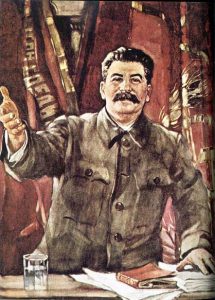
On this same day, the Soviet Union also signed a Treaty of Mutual Assistance with the Baltic nation of Estonia, giving Stalin the right to occupy Estonian naval and air bases. What was thought to be a buffer zone, seems more like a land grab to me. A similar treaty would later be signed with Latvia. These nations really didn’t seem to realize what they were getting into. Eventually, Soviet tanks rolled across these borders, in the name of “mutual assistance,” placing the Baltic States under the rule of the USSR for decades to come. These so called treaties were once again merely the realization of more fine print from the Ribbentrop-Molotov Pact, giving Stalin more border states as buffer zones, and protecting Russian territory where the Bolshevik ideology had not been enthusiastically embraced from intrusion by its western neighbor, namely its non-aggression partner Germany. The highly vulnerable Baltic nations had no say in any of these arrangements. They were merely annexed…by force in a huge Soviet land grab.
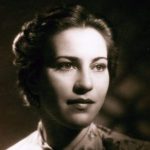 Born Jewish, on April 4, 1922, in Berlin, Germany, did not necessarily set Marie Jalowicz up for a long carefree life. Marie was 11 years old when the Nazi Party came to power, and soon after began to imprison her family members. By age 20, Marie was forced to fend for herself. She found herself faced with the difficult task of constantly avoiding the Nazis. For Marie, this meant somehow assimilating into German life…basically pretending to be a non-Jew. I can’t imagine having to pretend to be a nationality other than my own, but that is what she had to do. Anything about her that was Jewish had to be set aside, forgotten, or hidden from the eyes and ears of the Nazis, who seemed to be everywhere around her.
Born Jewish, on April 4, 1922, in Berlin, Germany, did not necessarily set Marie Jalowicz up for a long carefree life. Marie was 11 years old when the Nazi Party came to power, and soon after began to imprison her family members. By age 20, Marie was forced to fend for herself. She found herself faced with the difficult task of constantly avoiding the Nazis. For Marie, this meant somehow assimilating into German life…basically pretending to be a non-Jew. I can’t imagine having to pretend to be a nationality other than my own, but that is what she had to do. Anything about her that was Jewish had to be set aside, forgotten, or hidden from the eyes and ears of the Nazis, who seemed to be everywhere around her.
Marie knew that as the situation for Jews in Nazi Germany deteriorated, things would grow steadily worse for her. She had to somehow come up with a way to virtually hide in plain sight. When a postman wrongly delivered a letter for a job offer intended for the neighbor in 1941, she told a postman that her “neighbor” Marie was taken by the Nazis, then she simply started walking around without a star on her jacket. She was successfully living under a false identity. She took the job and began 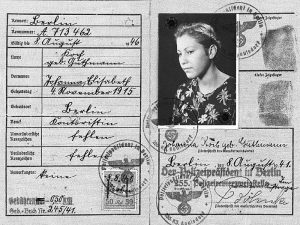 working at the Siemens arms factory in her neighbor’s place. While living this double life, Jalowicz sabotaged production at the arms factory where she worked. Marie evaded Nazi capture through a long string of forgeries, impersonations, and help from people from every walk of life. Marie became Johanna Koch, using her wit and charm to seduce people in positions that could help her and moved around constantly. She took the words of a friend of hers to heart, “In absurd times, everything is absurd. You can save yourselves only by absurd means since the Nazis are out to murder us all.” On more than one occasion she tried to flee Germany, narrowly evading apprehension and escaping back to her homeland each time. She relocated often, and at one point was sold to an abusive Nazi with late-stage syphilis for 15 marks, which added to her cover as a non-Jew. In the coming years, she took menial jobs and lived in several Berlin flats, at times with roommates who were fervent Nazis. I can’t imagine how awful it was for her.
working at the Siemens arms factory in her neighbor’s place. While living this double life, Jalowicz sabotaged production at the arms factory where she worked. Marie evaded Nazi capture through a long string of forgeries, impersonations, and help from people from every walk of life. Marie became Johanna Koch, using her wit and charm to seduce people in positions that could help her and moved around constantly. She took the words of a friend of hers to heart, “In absurd times, everything is absurd. You can save yourselves only by absurd means since the Nazis are out to murder us all.” On more than one occasion she tried to flee Germany, narrowly evading apprehension and escaping back to her homeland each time. She relocated often, and at one point was sold to an abusive Nazi with late-stage syphilis for 15 marks, which added to her cover as a non-Jew. In the coming years, she took menial jobs and lived in several Berlin flats, at times with roommates who were fervent Nazis. I can’t imagine how awful it was for her.
Marie went on to become a German philologist and historian of philosophy, pursued a career in academia, 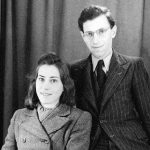 and received a Ph.D. in ancient literature and art history at Berlin’s Humboldt University. Then, after the war, she become a professor at Humboldt University, where she worked until her death in 1998. Just before her death she recorded 77 cassette tapes of audio with her son, Hermann. In the tapes, for the first time, Marie chronicled her experience during the Nazi reign. They were later compiled into a book called, Underground in Berlin: A Young Woman’s Extraordinary Tale of Survival in the Heart of Nazi Germany. She became known to larger audiences for this, her autobiographical account of the persecution of Jews in Nazi Germany, which was published posthumously. Marie died on September 16, 1998. She returned to her original identity only on her deathbed. Her mother died of cancer in 1938. Her father died in 1941. She is survived by her only son, Hermann Simon.
and received a Ph.D. in ancient literature and art history at Berlin’s Humboldt University. Then, after the war, she become a professor at Humboldt University, where she worked until her death in 1998. Just before her death she recorded 77 cassette tapes of audio with her son, Hermann. In the tapes, for the first time, Marie chronicled her experience during the Nazi reign. They were later compiled into a book called, Underground in Berlin: A Young Woman’s Extraordinary Tale of Survival in the Heart of Nazi Germany. She became known to larger audiences for this, her autobiographical account of the persecution of Jews in Nazi Germany, which was published posthumously. Marie died on September 16, 1998. She returned to her original identity only on her deathbed. Her mother died of cancer in 1938. Her father died in 1941. She is survived by her only son, Hermann Simon.

